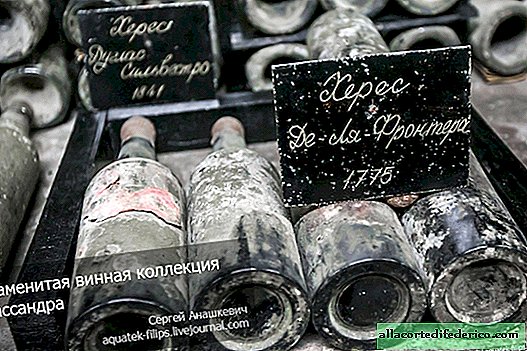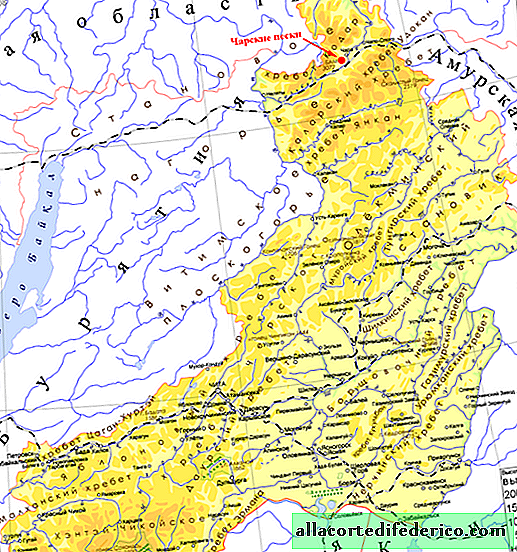Massandra's famous wine collection
This collection is listed in the Guinness Book of Records as the greatest treasury of wines due to the variety of names and their uniqueness. During the war, she was evacuated from Crimea in an extraordinary order. Numbered bottles were preferred over people, plant equipment and museum exhibits. The collection survived several difficult historical periods, and it was possible to keep it almost intact to the present day.
Anyone who knows wine can see truly unique specimens here, some of which can only be found in these cellars.
Part of the collection is available for inspection by visitors to the Massandra winery, but the most valuable part of it is not available to ordinary tourists. This is the part you can see in this post ...

The very idea of creating a wine collection was due to the fact that old wines are impeccable in terms of taste, uniqueness due to small volumes of production and ecology. All this led to the fact that wines began to be laid for long-term storage, even in significant quantities. There was an interest in rare wines, in wines by attachment, in wines of a particular year's harvest. That is how entire collections of old wines began to be created.
The Massandra collection is one of the largest, richest and most famous collections in the world. The beginning of the collection is associated with the name of L. S. Golitsyn. He with great taste, stubbornly, sparing neither energy nor money, collected for his collection all the best that he found in all the wine cellars of the world. In addition, starting in 1897, the collection began to lay in small quantities all the wines produced by Massandra itself.

The Massandra collection has always been, without exaggeration, a historical relic of domestic winemaking, a treasury of the work of thousands of people, in which each bottle, like a book, has its own content, its authors and its own history. Many brands of wines are represented by a very small number of bottles.
The collection contains dozens of standards of centenary drinks "Massandra" and many European countries. In 1941, when the Great Patriotic War began, the heroic efforts of workers and specialists in a very short time prepared and sent by sea to Novorossiysk, and then to the rear, thousands of wine bottles that returned to the walls of the plant only four years later.
Now enoteca is located in 10 galleries and has about 1 million bottles of unique collection wines. Here, at a considerable depth, the temperature is always the same - 4-14 ° С.

The walls of the gallery are equipped with deep stone niches. In each of them there are up to 300 bottles of wine of a certain brand.

The Massandra Collection Fund consists of three parts:
1. The museum fund, which is discussed in this post and which is of great value. The wines contained in it can be called "rarities." This fund will be kept forever, for posterity, as an assortment collection. Wines from it are not for sale.
2. Advertising research and training fund - created to participate in salons, auctions and exhibitions; to study changes in wines during long-term storage in bottles; as well as for training and acquaintance of wine-makers with unique samples of wines and processes that occur during the maturation and aging of these divine drinks.
3. Commercial fund

All bottles are corked with an “extra” cork stopper (the cork is filled with sealing wax) and laid in a horizontal position without access to the inside of the air. The external condition of the bottles is checked systematically, and after every 15-20 years the cork is replaced. In the dungeons, the bottle is covered with a coating - “the noble dust of centuries”, which serves as a kind of passport for the bottle and gives a certain charm. Therefore, rubbing and transferring bottles in the collection is strictly prohibited.

Each tab has its own passport, which contains all the data on the wine, its quantity and dates when the bottles were re-opened.

By the way, there is a device that is designed specifically for re-corking processes. More specifically, it is used to crimp plugs that need to be sealed to reduce diameter. The thing is that the bottlenecks of different years can vary quite a bit in internal diameter and it’s quite problematic to select a cork for several copies. Therefore, it is squeezed, fitting to the desired diameter.

Among the rare samples of the collection are wines of foreign countries:
1. Muscat "Barcelona" harvest 1828.
2. Sherry "India" harvest 1870
3. Marsala "Floria" and the Chateau "Ikem" vintage 1865
4. Muscat "Lunel" and Sherry "Paharet" harvest 1848
5. Madeira "Ribeiro Secco" harvest 1837
6. Sherry "Portuguese" harvest 1847
7. Muscat "Tunisian", Sherry "Santa Maria", Sherry "Gloria", Port "Consular" vintage 1830
8. The oldest unique - "Jerez de la Frontera" harvest of 1775.
You will see most of them in this post.
In the meantime, I propose to look at some of the most interesting instances of the collection from younger to older wines.



By the way, during the occupation of Crimea by the Germans, the Massandra plant continued to operate. Some of the wines bottled in 1942-1943 can also be seen in the collection.


See how sometimes the bottles of the same brands of wine differ.


On some bottles, numbers printed in white can be seen. This is a preserved evacuation marking.


Below are the most rare and rare specimens of the collection.























